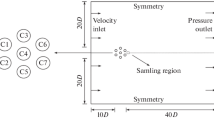Abstract
Flow development in the wake of a dual step cylinder has been investigated experimentally using Laser Doppler Velocimetry and flow visualization. The dual step cylinder model is comprised of a large diameter cylinder (D) mounted at the mid-span of a small diameter cylinder (d). The experiments have been performed for a Reynolds number (Re D ) of 1,050, a diameter ratio (D/d) of 2, and a range of large cylinder aspect ratios (L/D). The results show that the flow development is highly dependent on L/D. The following four distinct flow regimes can be identified based on vortex dynamics in the wake of the large cylinder: (1) for L/D ≥ 15, three vortex shedding cells form in the wake of the large cylinder, one central cell bounded by two cells of lower frequency, (2) for 8 < L/D ≤ 14, a single vortex shedding cell forms in the wake of the large cylinder, (3) for 2 < L/D ≤ 6, vortex shedding from the large cylinder is highly three-dimensional. When spanwise vortices are shed, they deform substantially and attain a hairpin shape in the near wake, (4) for 0.2 ≤ L/D ≤ 1, the large cylinder induces vortex dislocations between small cylinder vortices. The results show that for Regimes I to III, on the average, the frequency of vortex shedding in the large cylinder wake decreases with L/D, which is accompanied by a decrease in coherence of the shed vortices. In Regime IV, small cylinder vortices connect across the large cylinder wake, but these connections are interrupted by vortex dislocations. With decreasing L/D, the frequency of dislocations decreases and the dominant frequency in the large cylinder wake increases toward the small cylinder shedding frequency.


















Similar content being viewed by others
References
Adrian RJ, Yao CS (1987) Power spectra of fluid velocities measured by laser Doppler velocimetry. Exp Fluids 5:17–28
Ayoub A, Karamcheti K (1982) An experiment on the flow past a finite circular cylinder at high subcritical and supercritical Reynolds numbers. J Fluid Mech 118:1–26
Dunn W (2004) Vortex shedding from cylinders with step-changes in diameter in uniform and shear flows. PhD Thesis, Department of Mechanical Engineering, University of Ottawa, Canada
Dunn W, Tavoularis S (2006) Experimental studies of vortices shed from cylinders with a step-change in diameter. J Fluid Mech 555:409–437
Gerrard GH (1978) The wakes of cylindrical bluff bodies at low Reynolds number. Phil Trans Royal Soc London A 288:351–382
Inoue O, Sakuragi A (2008) Vortex shedding from a circular cylinder of finite length at low Reynolds numbers. Phys Fluids 20:033601
Lewis CG, Gharib M (1992) An exploration of the wake three dimensionalities caused by a local discontinuity in cylinder diameter. Phys Fluids A 4:104–117
Morton C, Yarusevych S (2010) Vortex shedding in the wake of a step cylinder. Phys Fluids 22:083602
Nakamura H, Igarashi T (2008) Omnidirectional reductions in drag and fluctuating forces for a circular cylinder by attaching rings. J Wind Eng Indust Aerodyn 96:887–899
Norberg C (1992) An experimental study of the flow around cylinders joined with a step in diameter. 11th Australasian Fluid Mechanics Conference, 14–18 Dec., Hobart, Australia
Norberg C (1994) An experimental investigation of the flow around a circular cylinder: influence of aspect ratio. J Fluid Mech 258:287–316
Norberg C (2003) Fluctuating lift on a circular cylinder: review and new measurements. J Fluids Struct 17:57–96
Roshko A (1993) Perspectives on bluff body aerodynamics. J Wind Eng Indust Aerodyn 49:79–100
West GH, Fox TA (1990) On the use of end plates with circular cylinders. Exp Fluids 9:237–239
Williamson CHK (1988) The existence of two stages in the transition to three-dimensionality of a cylinder wake. Phys Fluids 31(11):3165–3168
Williamson CHK (1989) Oblique and parallel modes of vortex shedding in the wake of a circular cylinder at low reynolds numbers. J Fluid Mech 206:579–627
Williamson CHK (1992) The natural and forced formation of spot-like ‘vortex dislocations’ in the transition of a wake. J Fluid Mech 243:393–441
Williamson CHK (1996) Vortex dynamics in the cylinder wake. Annu Rev Fluid Mech 28:477–539
Zdravkovich MM, Brand VP, Mathew G, Weston A (1989) Flow past short circular cylinders with two free ends. J Fluid Mech 203:557–575
Acknowledgments
The authors gratefully acknowledge the Natural Sciences and Engineering Research Council of Canada (NSERC) for funding of this work.
Author information
Authors and Affiliations
Corresponding author
Electronic supplementary material
Below is the link to the electronic supplementary material.
Rights and permissions
About this article
Cite this article
Morton, C., Yarusevych, S. An experimental investigation of flow past a dual step cylinder. Exp Fluids 52, 69–83 (2012). https://doi.org/10.1007/s00348-011-1186-z
Received:
Revised:
Accepted:
Published:
Issue Date:
DOI: https://doi.org/10.1007/s00348-011-1186-z




